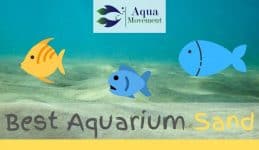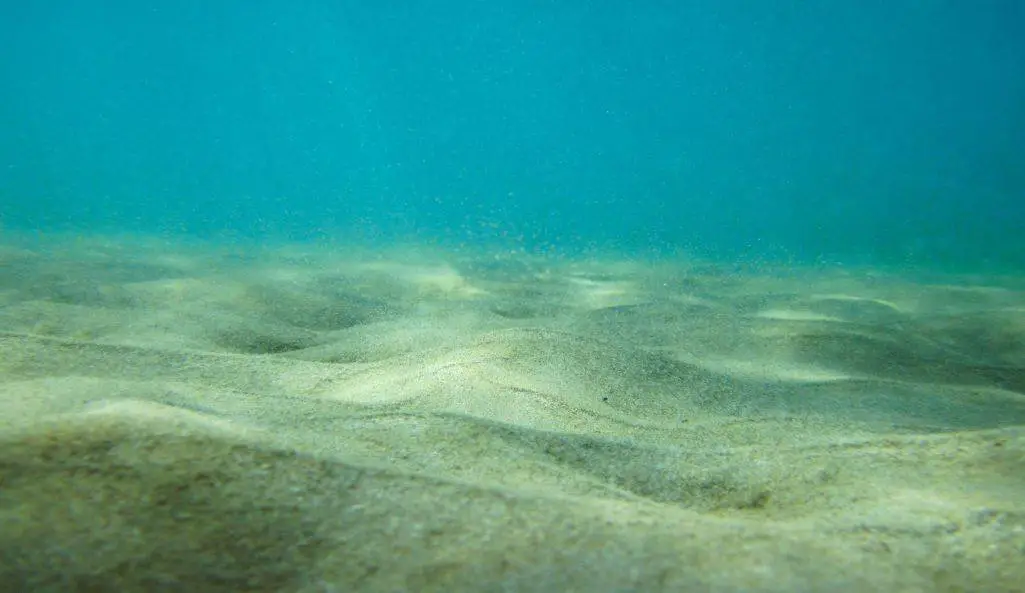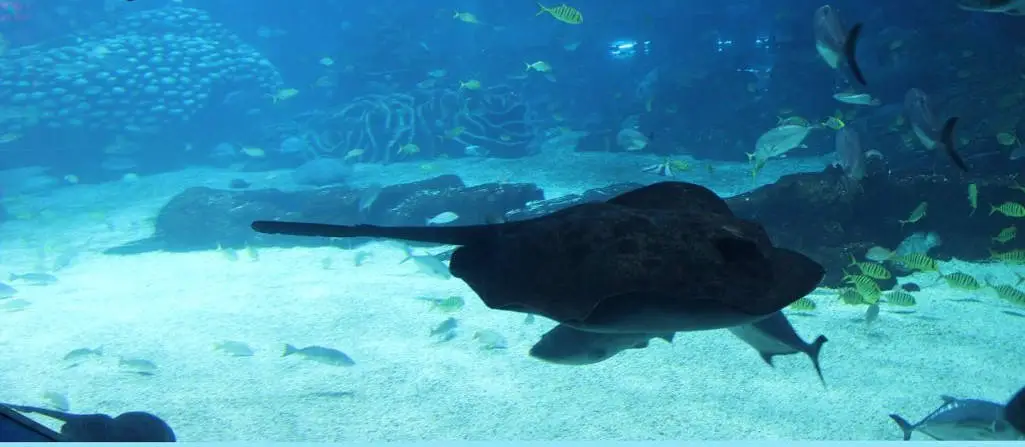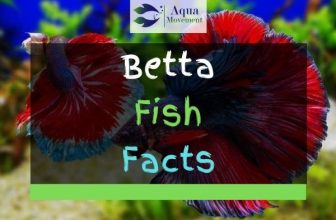
Best Aquarium Sand for Freshwater and Saltwater Reviewed
It is easy to think that sand substrates are only meant to make your aquarium stand out. After all, they come in a variety of colors and textures, meaning you can fashion any look you want out of your aquarium.
The truth is that sand substrates play an important role in the health of the fish you place in your aquarium as well.
In fact, the sand substrate is the most important feature of a fish tank. If you’ve decided to get an aquarium for your home or are looking to upgrade what you already have, selecting the right sand substrate is important.
Choosing the best aquarium sand is key to thriving, healthy and beautiful fish and plants.
For that reason, we have reviewed the top 6 products to help you find the right sand for your fish tank.
[amazon table=”8043″]
Table of Contents
6 Best Aquarium Sand Substrates

CaribSea Arag-Alive Fiji Pink Sand
[amazon box=”B00025YVGC”]
This substrate is a great option for a saltwater aquarium. It features beneficial bacteria that facilitate the filtration process.
The beneficial bacteria help to clear all kinds of harmful debris and waste in water. Also, collectively, the bacteria form a powerful filtration system for the water.
Each 10-pound bag has millions of bacteria. The bacteria are programmed to minimize what is known as new tank syndrome. This is a condition where nitrites and ammonia levels build up to extremely dangerous levels. Such a phenomenon is common in an environment that has not had ample time to grow enough bacteria.
The sand has a near-perfect grain size. It’s small in size which makes it look attractive, but large enough not to be blown about in an aquarium. it’s sourced from the CaribSea, which is why it’s attractive and functional. The sand beautifies your tank by creating an environment that’s incredibly appealing to the eye.
The sand discourages the growth of algae, so you will not have to replace the substrate. The sand will start cycling immediately it is placed in the tank, and it works extremely fast compared to competing sand brands.
- Beautifies fish tanks
- Facilitates a powerful filtration mechanism
- Contains millions of beneficial bacteria
- Can stabilize pH
- Needs to be rinsed the first time you place it in a tank
Check Price and Reviews on Amazon
Video: “Live Aquarium Sand from CaribSea Explained”
Seachem Flourite Black Sand
[amazon box=”B0018CLX3C”]
Looking to purchase a brand of sand that is ideal for almost every aquarium?
Seachem’s Flourite Black is the ideal choice.
It is clay-based with gravel that is suitable for tanked plants. The advantage of using Flourite Black is that it does not need regular replacement. Also, it’s free of harmful elements that might prevent your plants from growing properly.
Fluorite is great if you wish to maintain a pH level, and it does so without compromising the quality of water in your aquarium. It has an abundant supply of iron, but it lacks other essential nutrients.
So, if you decide to purchase this substrate to support plants with delicate roots, we feel this won’t be the best sand for you.
That said, this sand substrate is able to meet the nutritional needs of an aquatic plant. Thus, you won’t be required to add gravel modifiers or extra nutrients to achieve the best outcome.
An important tip when using this substrate is that you should wash it before you place it in your aquarium. Otherwise, it’s highly probable that it might discolor your water.
- Lasts a long time
- All the elements in it are organic
- Consists of clay gravel
- Does not affect fish, plants or water
- Not ideal for plants with delicate roots
- Should be cleaned before placing in water
Check Price and Reviews on Amazon
Video: “Seachem flourite sand”
CaribSea ACS05820 Super Natural Moonlight Sand for Aquarium
[amazon box=”B00DDYZQ8Q”]
Another one of CaribSea’s great sand products is this substrate from their natural collection. While it’s mainly suited for freshwater conditions, you can place it in your saltwater tank because pH in this condition is neutral. The sand is neither alkaline nor acidic, which makes it a great choice for every aquarium owner.
Its white color contrasts beautifully with the enclosed aura in an aquarium. The sand is appealing to the eye because it has some shine to it.
When placed in an aquarium, it sparkles every now and then. So, it makes your tank aesthetically attractive and rich.
The sand features smooth grains making it an excellent option for aquarium with pets with a soft underbelly. In addition, since it’s free of paints and artificial dyes, it’s a safe substrate for your collection of exotic pets.
You can find it in a five-pound bag. But, you can purchase several bags if you prefer a deep sand layer in your tank.
- Good quality sand, stable and full of shine
- Soft grains, making it ideal for all kinds of aquatic pets
- Suitable for both fresh and saltwater
- Free of paints and dyes
- Grain size is too fine for some people
Check Price and Reviews on Amazon
Nature’s Ocean No.0 Bio-Activ Live Aragonite Live Sand
[amazon box=”B0018CIQAU”]
Nature’s Ocean stocks quality sand substrates that are absolutely natural. The sand is sourced from the ocean, so it contains live bacteria that will stabilize your aquarium within a very short time.
The process used to source the sand preserves almost all the bacteria in their natural environment. As a result, the bacteria will settle into your tank easily.
In fact, you can set up your aquarium and place fish and any coral you want into your tank the very same day. The sand features instant cycling, which helps to restore the natural balance inside your tank. This process facilitates the removal of waste and quickly eliminates nitrates and ammonia.
Nature’s Ocean contains aragonite, which helps to regulate nitrates and ammonia in your water. This element also maintains pH levels in your tank.
The substrate also contains a lot of beneficial microorganisms like autotrophs, heterotrophs, and chemolithotrophs whose main function is to maintain a balance in water.
The substrate offers plenty of surfaces for the bacteria to grow into large colonies, which is a welcoming environment for coral reefs.
- Contains aragonite
- Substrate features instant cycling
- Contains important autotrophs, and heterotrophs
- Stabilizes water pH
- Somewhat pricey
Check Price and Reviews on Amazon
Video: “Live Sand For Marine Reef Aquariums”
FairmountSantrol AquaQuartz Silica Sand
[amazon box=”B00JJ5GXSK”]
Are you thinking of sourcing a substrate that is both hassle- and fear-free for your aquarium? This product is a good choice if you are planning to keep exotic aquatic pets in your tank. It’s known to keep water in your aquarium crystal clear.
It will help you run a low maintenance aquarium by smothering the growth of problematic algae. The sand is also ecologically secure meaning it won’t clump together. It’s also odorless, inert, and 100 percent natural.
- Fairly priced, and sold by a trusted dealer
- High-quality sand arrives clean and ready to be placed in a tank
- Works really well in almost all kinds of aquatic environment
- Not compatible with Intex and few other filtration brands
- Bag of sand may come with extremely fine grains that may clog your filter
- Takes quite a while to cycle through filters
Check Price and Reviews on Amazon
CaribSea Ocean Direct Substrates
[amazon box=”B000YJMYPG”]
CaribSea is known for its quality sand substrates, but this particular one tops that list. It’s a very popular brand best suited for a saltwater aquarium.
Each bag of this substrate contains live and real sand. The sand also contains essential bacteria, whose main function is to clear waste from the water. In addition, the substrate is safe and is guaranteed to maintain level of pH in the water.
The company sources its sand and packages it in a manner that ensures almost all the bacteria is available when you place the sand. The sand is aesthetic to look at and is bound to beautify your tank by giving it a natural look.
This substrate is safe for your saltwater tank because it’s able to adjust and maintain pH at neutral every day. The best part is that unlike other brands, this one is processed in the U.S so you can be sure that its quality is of the highest standard.
- Contains millions of beneficial bacteria
- Sits and adorns your tank very well
- Stabilizes your pH
- Suitable for both salt and freshwater
- Manufactured and packaged in the U.S
- Needs rinsing before placing in a tank
Check Price and Reviews on Amazon
Video: “Live Aquarium Sand from CaribSea Explained”
Aquarium Sand Buying Guide
With plenty of sand substrates to choose from, settling on a specific type is such a huge task, especially if it’s your first time to set up an aquarium. Often, it is best to pick sand as your substrate of choice.
However, even when you decide to narrow down your list to a specific kind of substrate, there are plenty of other important things you should consider.
Reading through the features that each product offers is somewhat daunting. We understand how tough this can get. So, here are the key features that you should look for when choosing the best aquarium sand.
What to Add to Aquarium
An important consideration when buying sand is figuring out what you plan to add in your aquarium. If your plan is to have plants in the aquarium, then you should go for sand that will offer nutrients the plants will need to thrive.
It’s recommended that you place the nutrients inside the sand rather than in the water itself because plants use roots to source for the nutrients they need. In addition to this recommendation, it’s good practice to provide double layers of the sand substrate you choose.
Place your sand substrate on the top layer to prevent washout and nutrients on the bottom layer.
If the aquarium is designed for stocking fish, then your sand substrate should be shallow enough to block particles of food from reaching non-oxygenated areas. This way, toxic hydrogen sulfate won’t build up in the aquarium.
Colonization of Beneficial Bacteria
Also, your sand should facilitate the colonization of beneficial bacteria in your tank. Speaking of substrates and bacteria, there’s one main benefit that comes with placing sand substrate in your aquarium. That is, the sand provides a home to beneficial bacteria. Since there is plenty of surface on the sand, the bacteria have little crannies to live in.
The beneficial bacteria break down wastes generated in the aquarium. As the waste breaks down, the beneficial bacteria change it into ammonia. This gas is extremely toxic to both fish and plants, so the good bacteria convert it further into a compound called nitrite.
Nitrite is less toxic compared to ammonia. Then the bacteria break down nitrites into nitrates, which are toxic at very high quantities. Note that the bacteria in your tank can’t eliminate nitrates entirely. Only anaerobic bacteria, those found in an environment without oxygen, are known to decompose nitrates completely. For this reason, it’s vital that you change the water regularly.
Type of Water to Use
Companies develop different types of sand substrates to match the ecosystem you will have in your aquarium. So, you can’t place a sand substrate tailored for a freshwater ecosystem in a tank that uses salty water.
Thus, perform your due diligence to ensure you choose the correct kind of sand for the water you intend to use.
Amount of Substrate in Aquarium
Consider the capacity of your tank as a guide to help you know how much sand your tank will need.
As an example, if your tank’s capacity is 55 gallons, then you need about 2 inches worth of sand. However, bear in mind that if you’re placing plants in the tank, you will need an additional 1 inch of nutrients below the sand.
If you’re thinking of going big with your aquarium, you may need up to 3 inches of sand.
Particle Size
Generally, sand particles come in two sizes: coarse and fine. Finer sand is ideal when you wish to mimic a natural environment. The disadvantage with finer sand is that you may have to loosen it up once in a while because it tends to clump. As a result, some parts of the tank will have a low oxygen concentration.
Coarse sand does not require a lot of maintenance. But, you will have to clean it more often as food tends to get trapped between the particles. This can cause toxins to build up in the tank.
Color
There are plenty of options where color is concerned, so it boils down to taste and preferences, and the specific look you’re looking to achieve. Nevertheless, try not to purchase plant-colored sand. Otherwise, your fish might mistake it for food and eat it. Also, try as much as possible to match the sand to your fish’s natural habitat.
As for a planted tank, the other benefit of a sand substrate is that it provides plants with a surface for rooting. Some tank substrates have nutrients and minerals that encourage healthy growth in plants.
Best Aquarium Sand Brands

Seachem
Seachem is a privately owned pet care company with a wealth of experience in offering aquarist solutions to hobbyists. They have been in business for close to 40 years and currently sell their products in more than 60 countries around the world.
Their services cover a broad range of aquarium needs in seawater, freshwater, and ponds, as well as avian and herpetological husbandry.
Carib Sea
Founded about 13 years ago, CaribSea is one of the leading retailers of aquarium substrates.
They supply a range of aquarium accessories including sand, base rock, leaves, mycorrhizal fungi and much more.
World Wide Imports Enterprise, Inc.
With close to 40 years of experience, Nature’s Ocean understands everything there is to know about aquariums. They manufacture quality freshwater and marine products at the national and international level.
The company has a flagship of branded pet products and aquarium. They are known for many quality sub-brands, one of which is Nature’s Ocean.
FairmountSantrol
This company began its operations in 1978 as a producer of sand products whose main market was the oil and gas industry. FairmountSantrol also offers technical leadership and guidance to their customers in the building technology, foundry, sports, recreation, and water filtration markets.
FAQs
What is an aquarium substrate?
This is the material that you use to line your aquarium. Substrates are provided for functional and decorative purposes.
What are substrates used for?
Essentially, substrates occur naturally, and they are used to mimic an organism’s natural environment. They help to balance the level of nitrogen in the water, which influences the kind of bacteria living in them.
Although some people assume that every bacterium is harmful, or is responsible for the growth of algae, your aquarium needs certain types for plants to thrive.
Do I need a substrate for my aquarium?
If you are a newcomer, note that a substrate is not a must, but it helps to make the aquarium much more habitable.
It is common for some people not to include substrates in their tanks. However, you won’t be able to keep exotic fish or shrimp as they need dark places to rest and hide. If you don’t wish to include a substrate, at least place statues and some kind of housing. Your pets need shelter they can use to protect resources like food.
What are substrates made of?
Substrates can be found in the form of pebbles, sand, soil or gravel. But, you can find other forms that facilitate the nitrogen cycle when they interact with water.
These support life in the aquarium and are made up of Peat, Vermiculite and Aragonite.
You are not required to stick to a particular type. In fact, in some cases, it is a good idea to work with multiple types of substrates.
How much substrate should I place in my aquarium?
Based on rule of thumb, use one pound of substrate for each gallon if you want one inch of sand. This is applicable to a rectangular tank.
How do I test my preferred substrate?
Sometimes, people buy sand for an aquarium only to realize they made a mistake after placing it in the tank. If you are not certain about the outcome once you add substrate to your tank, try a smaller container full of water for a start.
Allow the water to stand for a couple of days, observe how long it takes to settle and whether there are clumps. This will give you an idea as to how the substrate will impact the filtration system and the ecosystem in the tank in general.
How do I clean my substrate before placing it in my aquarium?
You should always place clean substrates in your tank to prevent water from turning cloudy. So, wash your substrate thoroughly. One trick that works is to place your sand or pebbles in a bucket and clean it with a hose. Pour out any dirty water each time you clean the substrate.
How often should I change my substrate?
This is determined by the substrate you choose. If your sand raises the water’s pH, you need to change it every few months or years. A clay substrate should be changed every 4 years. A plant-based substrate needs changing much more frequently while gravel and sand don’t need to be changed.
[amazon table=”8043″]
Conclusion
An aquarium requires a perfectly balanced environment, which can be difficult to pull off. For that reason, you need to find the right substrate. We have listed some great choices, and you can be sure they are all natural and sourced with beneficial microorganisms intact.
By choosing the best aquarium sand, your tank will not only look appealing but you’ll also have an easy time managing your aquatic pets or plants. When you provide the right kind of microorganism(s) for your type of water, the substrate will keep your water clean and maintain a level of pH.
Our choice for best aquarium sand is the CaribSea Arag-Alive Pink Fiji Sand. This substrate is appealing to look at and has all the essential elements necessary to keep your water waste free.
Plus, you won’t have to replace it or add any chemicals. Simply add a couple of janitors into your water and they help you turn the substrate over. Your only task will be to use a vacuum to clear debris off the surface when necessary.




